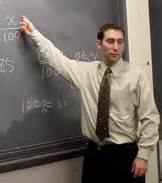
A national teacher shortage could be looming, due to changing admissions standards at teaching colleges.
The Impending Teacher Shortage
By Marc F. Bernstein/ Adjunct faculty member, Fordham U. Graduate School of Education
Posted: 10/10/2013 5:30 pm
By the year 2020 there will be a serious teacher shortage, especially in the more demanding subject areas of mathematics and science. Fortunately, there is time to take the necessary steps to turn this shortage into a meaningful education reform that will improve the quality of and broaden the racial demographics of those individuals who enter the teaching profession.
This impending shortage is the result of an ambitious plan recently adopted by the Council for Accreditation of Educator Preparation (CAEP), a voluntary organization of the nation’s higher education teacher preparation programs which includes approximately 2/3 of those institutions, to raise admission requirements for future applicants to teacher colleges. Quoting from their June 2013 report:
The provider (the institution of higher education) ensures that the average grade point average of its accepted cohort of candidates meets or exceeds the CAEP minimum of 3.0, and the group average performance on nationally-normed ability/achievement assessments such as ACT, SAT, or GRE is in the top 50% from 2016 – 2017; is in the top 40% of the distribution from 2018 – 2019; and is in the top 33% of the distribution by 2020.
Whether we like the use of SAT scores or not, this accreditation association requirement carries incredible weight for university teacher preparation programs.

Changes within Teacher Preparation Programs could very well translate into a shortage of minority or STEM teachers.
There is little doubt that the pool of future “qualified” applicants will shrink significantly because of this change unless the federal and state governments step-in with incentives to encourage high school graduates who previously shunned teaching as a career due to the cost of four to six years of college and graduate school tuitions and the prospect of low career earnings. This problem will be greatest at the middle school and high school levels where individuals who are considering teaching as a profession possess interest in specific fields such as mathematics and science ( but also art, foreign language, and music, to name a few) where alternative areas of employment are available and often more lucrative.
But, here is where government can do something: implement a policy to forgive student loans to those college students who attend programs that meet all of the Association’s more rigorous admission standards, graduate in no more than five years, and who pass state certification examinations.
It is generally accepted that the teacher is the key (controllable) element in a student’s success (as compared to the role of parents and situations of poverty). Since few disagree that education is the best vehicle to reduce income inequality and to promote opportunity, factors which contribute mightily to our country’s future, forgiving student loans for the most qualified Americans to encourage them to enter the field of education seems a very small national investment, especially since loan forgiveness is contingent upon individual’s fulfilling their responsibilities.


